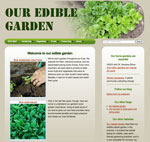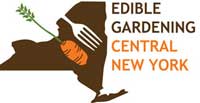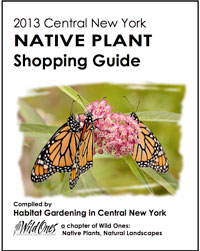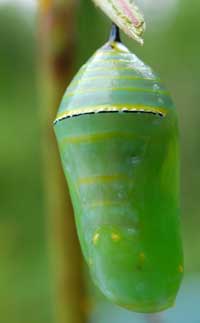Garden Pests
Presented by
Edible Gardening CNY |
 | Flea beetles: small insects, big appetites
|
|
Tues., June 4, 6:30 pm at Cicero Public Library
and
Thurs., June 6, 7:00 pm
at DeWitt Community Library Both presentations of this topic are free and open to the public Learn more about edible gardening in CNY
|
| Our Habitat Garden |  |
Visit Our Habitat Garden website for information on providing habitat, earth-friendly gardening practices, plants, and various creatures here in Central New York.
|
HGCNY Officers
| |
| President:
Janet Allen
Vice-President:
Carol Biesemeyer
Treasurer:
Randi Starmer
Secretary:
Soule Leiter
Membership:
Linda Rossiter
Program Chair:
Carol Biesemeyer
Newsletter Editor:
Janet Allen
Additional Planning Committee Members:
Beth Mitchell
Dave Mitchell
John Allen
Peter Huntington
|
| HGCNY on Facebook |
As as more of us participate on our Facebook page, this will become a useful resource for asking (and answering!) local HGCNYers' questions about habitat gardening. |
|
Join HGCNY!
|  |
Becoming an official member of HGCNY is easy: just join Wild Ones! Basic household membership is $37/year, but there are other options, too. (See membership application or website.)
Wild Ones
P.O. Box 1274
Appleton, Wisconsin 54912-1274
Make checks payable to Wild Ones.
Or telephone toll-free 877-394-9453.
|
|
Our Edible Garden
|  | Visit OurEdibleGarden.org to see an example of a Central New York edible garden, the perfect companion to your habitat garden.
|
| Interested in Edible Gardening? | 
|
If you'd like to get information on Edible Gardening CNY, just email John to find out about edible gardening tours and monthly programs. Free and open to the public! |
|
Greetings!
 | Click image to download the Shopping Guide (a .pdf file)
|
Where to find native plants
Are you looking for native plants in general or even a particular native plant? Chances are, you can find them somewhere in CNY. Our 2013 Native Plant Shopping Guide shows you where. You're welcome to download it by clicking on the image to the right, OR you can download it from our website homepage (midway down the page). It's free! As always, we recommend that you call ahead if you're looking for a particular plant. Some less common native plants may be in short supply, and you wouldn't want to waste a trip to find that your plant had sold out.
Summer Show Me Help Me ToursIn the summer, we look forward to visiting habitat gardens, large and small, urban and suburban. We'll be announcing the dates and locations in future newsletters. Your habitat garden? Have you been working on creating your habitat garden with native plants? If you'd like to share what you've done and perhaps have some of your questions answered, contact me and we'll add you to the list of possible garden tours. We'll plan our summer garden tour schedule in June.
Creating a Monarch Waystation
Thurs. June 13 at 7:00 pm Creating a Monarch Waystation Dewitt Community Library - free and open to the public.
Janet Allen President, HGCNY |
|
|
Guess what this is (answer below)
|
|
Baltimore orioles (not the team)
 | | Oriole with milkweed stalk fibers |
It's always a treat to see Baltimore orioles, but for some of us, it's a rare treat.
Even more of a treat is to see the female gathering nesting materials, in this case, the fibers from last year's swamp milkweed stalks.
So not only are milkweeds essential food for monarch butterfly caterpillars, but they're also bird nesting materials! In addition to providing habitat (including nesting materials) here in their summer breeding territory, we can help Baltimore orioles by purchasing shade grown coffee grown in their overwintering habitat in Central America. By buying shade-grown coffee, you prevent even more of their winter habitat from being converted to sun coffee plantations, which are biological deserts. ( Read more about this issue, including some where to find it ...)
|
|
What's inside that butterfly pupa?
 | | What's happening in there? |
The National Geographic has some amazing 3-D scans that reveal caterpillars turning into butterflies.
From the article:
We know that a larva releases enzymes that break down many of its tissues into their constituent proteins.
Textbooks will commonly talk about the insect dissolving into a kind of "soup", but that's not entirely accurate. Some organs stay intact. Others, like muscles, break down into clumps of cells that can be re-used, like a Lego sculpture decomposing into bricks.
And some cells create imaginal discs--structures that produce adult body parts. There's a pair for the antennae, a pair for the eyes, one for each leg and wing, and so on. So if the pupa contains a soup, it's an organised broth full of chunky bits.
|
|
Lots of projects to make your summer more fun and interesting
 | House sparrow with nesting materials, perhaps ready to invade some other birds' nest
|
House Sparrow Project
This project, sponsored by Hunter College and Cornell Lab of Ornithology, collaborates with citizens to study and develop management methods for House Sparrows in their non-native range.
You can:
* Collectively design best practices for house sparrow management. Participants and researchers will discuss the array of management practices out there and collectively design a field experiment to evaluate a subset of these.
* Advance research by collecting much needed data on nesting behavior and egg recognition. The research is fun: color eggs, take photos, collect, share and compare information with others.
* Participate in discussion groups online to share your insight and ideas.
Citizen science projects
One of the most exciting parts of our digital age is that it gives everyone the opportunity to make a difference. Participating in citizen science projects is one such way. There's such a surprising and ever-increasing number of projects available that everyone is sure to find a project that appeals to them.
I've compiled a table listing just some of these projects. Check them out and see if there's one -- or even a few -- that catch your fancy. The list is available on the Our Habitat Garden Citizen Science webpage (in the right sidebar).
YardWorks Contest: Neighbors Join Forces to Create Bird-Friendly Yards
An area the size of West Virginia is converted to residential use each decade, leaving less habitat to support wildlife. But many people use their yards to help birds and other wildlife by setting up feeders, building nest boxes, or putting in special plants.
With that in mind, the Cornell Lab of Ornithology's YardMap Project, in partnership with the Cornell University Dept of Landscape Architecture, is hosting a unique contest. Groups of neighbors across New York State are invited to work together to build larger networks of bird-friendly habitat.
Contest winners will receive free landscape design advice from the Cornell Department of Landscape Architecture.
Find out more about this contest. Deadline: June 25.
Monarch Larva Monitoring Project
This project was developed by researchers at the Univ. of Minnesota to collect long-term data on larval monarch populations and milkweed habitat. The goal is to better understand how and why monarch populations vary in time and space. As an MLMP volunteer, your contributions will aid in conserving monarchs and their threatened migratory phenomenon, and advance our understanding of butterfly ecology in general. This year: An online training video series is available. |
|
Mystery image answer
 | | Downy woodpecker |
This is a male downy woodpecker. (The female doesn't have the red patch on her head.)
He was busy working on this fence post for quite a while.
What is he watching so intently? (See the photo below.)  | Ants carrying eggs
|
He had discovered ants frantically moving their eggs from under the metal top of the fence post to safety below. Not all of them made the trip safely since the downy eagerly gobbled up all the ones he could get!
|
|
|
|
|